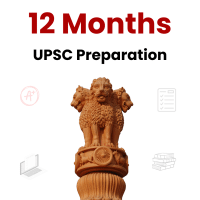UPSC Exam > UPSC Questions > The transformation of Delhi into a capital th...
Start Learning for Free
The transformation of Delhi into a capital that controlled vast areas of the subcontinent started with the foundation of the Delhi Sultanate in the beginning of the
- a)Thirteenth century
- b)Twelfth century
- c)Eleventh century
- d)Eighteenth century
Correct answer is option 'A'. Can you explain this answer?
Most Upvoted Answer
The transformation of Delhi into a capital that controlled vast areas ...
The transformation of Delhi into a capital that controlled vast areas of the subcontinent started with the foundation of the Delhi Sultanate in the beginning of the thirteenth century. The Delhi Sultans built many cities in the area that we now know as Delhi.
Free Test
FREE
| Start Free Test |
Community Answer
The transformation of Delhi into a capital that controlled vast areas ...
How is it possible, delhi first became capital under the rajputs in the twelfth century

|
Explore Courses for UPSC exam
|

|
Question Description
The transformation of Delhi into a capital that controlled vast areas of the subcontinent started with the foundation of the Delhi Sultanate in the beginning of thea)Thirteenth centuryb)Twelfth centuryc)Eleventh centuryd)Eighteenth centuryCorrect answer is option 'A'. Can you explain this answer? for UPSC 2025 is part of UPSC preparation. The Question and answers have been prepared according to the UPSC exam syllabus. Information about The transformation of Delhi into a capital that controlled vast areas of the subcontinent started with the foundation of the Delhi Sultanate in the beginning of thea)Thirteenth centuryb)Twelfth centuryc)Eleventh centuryd)Eighteenth centuryCorrect answer is option 'A'. Can you explain this answer? covers all topics & solutions for UPSC 2025 Exam. Find important definitions, questions, meanings, examples, exercises and tests below for The transformation of Delhi into a capital that controlled vast areas of the subcontinent started with the foundation of the Delhi Sultanate in the beginning of thea)Thirteenth centuryb)Twelfth centuryc)Eleventh centuryd)Eighteenth centuryCorrect answer is option 'A'. Can you explain this answer?.
The transformation of Delhi into a capital that controlled vast areas of the subcontinent started with the foundation of the Delhi Sultanate in the beginning of thea)Thirteenth centuryb)Twelfth centuryc)Eleventh centuryd)Eighteenth centuryCorrect answer is option 'A'. Can you explain this answer? for UPSC 2025 is part of UPSC preparation. The Question and answers have been prepared according to the UPSC exam syllabus. Information about The transformation of Delhi into a capital that controlled vast areas of the subcontinent started with the foundation of the Delhi Sultanate in the beginning of thea)Thirteenth centuryb)Twelfth centuryc)Eleventh centuryd)Eighteenth centuryCorrect answer is option 'A'. Can you explain this answer? covers all topics & solutions for UPSC 2025 Exam. Find important definitions, questions, meanings, examples, exercises and tests below for The transformation of Delhi into a capital that controlled vast areas of the subcontinent started with the foundation of the Delhi Sultanate in the beginning of thea)Thirteenth centuryb)Twelfth centuryc)Eleventh centuryd)Eighteenth centuryCorrect answer is option 'A'. Can you explain this answer?.
Solutions for The transformation of Delhi into a capital that controlled vast areas of the subcontinent started with the foundation of the Delhi Sultanate in the beginning of thea)Thirteenth centuryb)Twelfth centuryc)Eleventh centuryd)Eighteenth centuryCorrect answer is option 'A'. Can you explain this answer? in English & in Hindi are available as part of our courses for UPSC.
Download more important topics, notes, lectures and mock test series for UPSC Exam by signing up for free.
Here you can find the meaning of The transformation of Delhi into a capital that controlled vast areas of the subcontinent started with the foundation of the Delhi Sultanate in the beginning of thea)Thirteenth centuryb)Twelfth centuryc)Eleventh centuryd)Eighteenth centuryCorrect answer is option 'A'. Can you explain this answer? defined & explained in the simplest way possible. Besides giving the explanation of
The transformation of Delhi into a capital that controlled vast areas of the subcontinent started with the foundation of the Delhi Sultanate in the beginning of thea)Thirteenth centuryb)Twelfth centuryc)Eleventh centuryd)Eighteenth centuryCorrect answer is option 'A'. Can you explain this answer?, a detailed solution for The transformation of Delhi into a capital that controlled vast areas of the subcontinent started with the foundation of the Delhi Sultanate in the beginning of thea)Thirteenth centuryb)Twelfth centuryc)Eleventh centuryd)Eighteenth centuryCorrect answer is option 'A'. Can you explain this answer? has been provided alongside types of The transformation of Delhi into a capital that controlled vast areas of the subcontinent started with the foundation of the Delhi Sultanate in the beginning of thea)Thirteenth centuryb)Twelfth centuryc)Eleventh centuryd)Eighteenth centuryCorrect answer is option 'A'. Can you explain this answer? theory, EduRev gives you an
ample number of questions to practice The transformation of Delhi into a capital that controlled vast areas of the subcontinent started with the foundation of the Delhi Sultanate in the beginning of thea)Thirteenth centuryb)Twelfth centuryc)Eleventh centuryd)Eighteenth centuryCorrect answer is option 'A'. Can you explain this answer? tests, examples and also practice UPSC tests.

|
Explore Courses for UPSC exam
|

|
Signup for Free!
Signup to see your scores go up within 7 days! Learn & Practice with 1000+ FREE Notes, Videos & Tests.
























